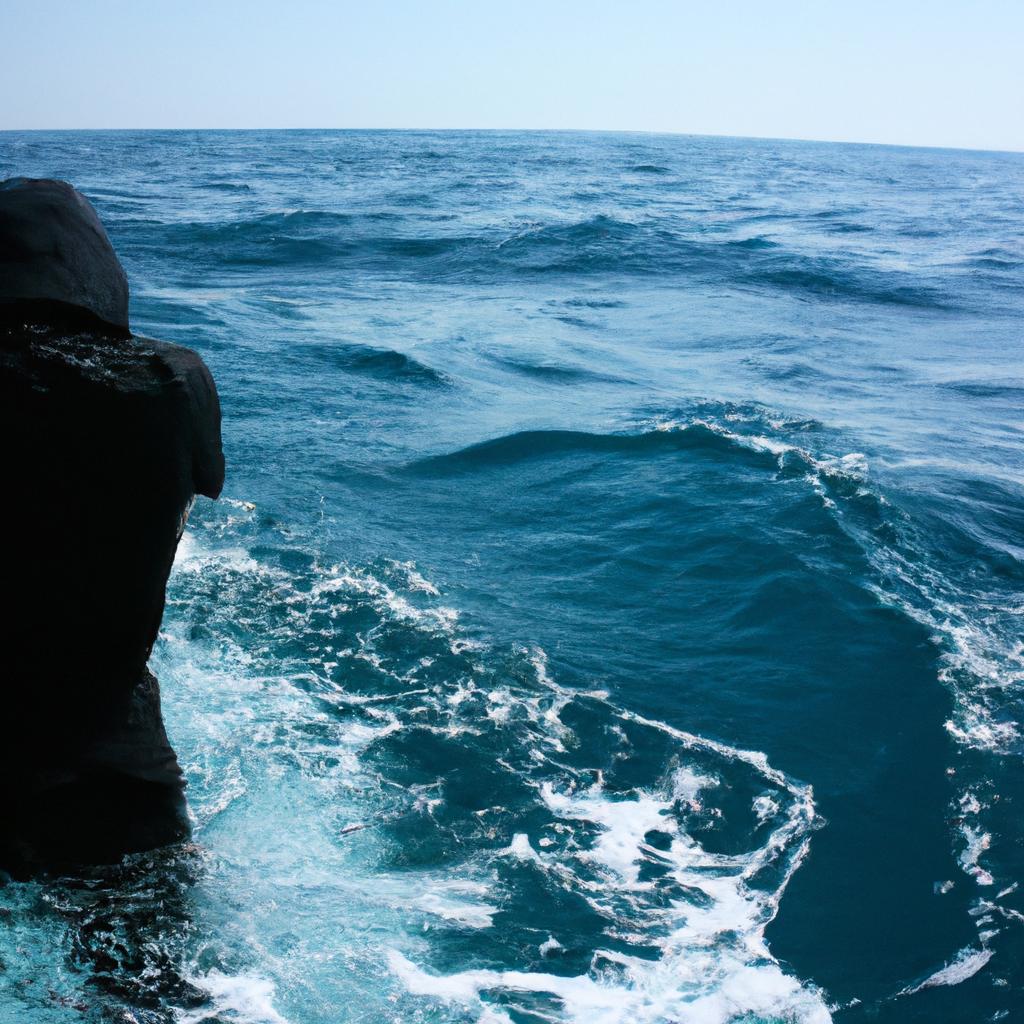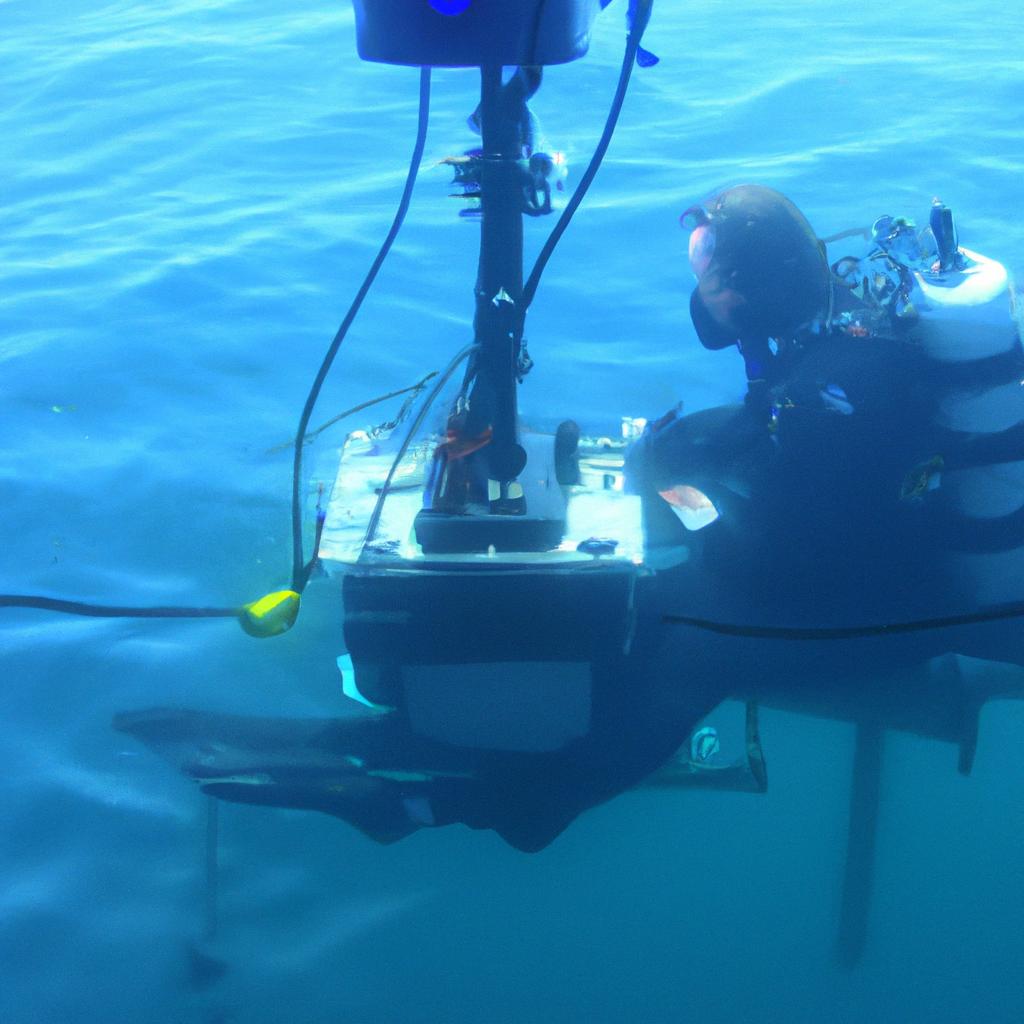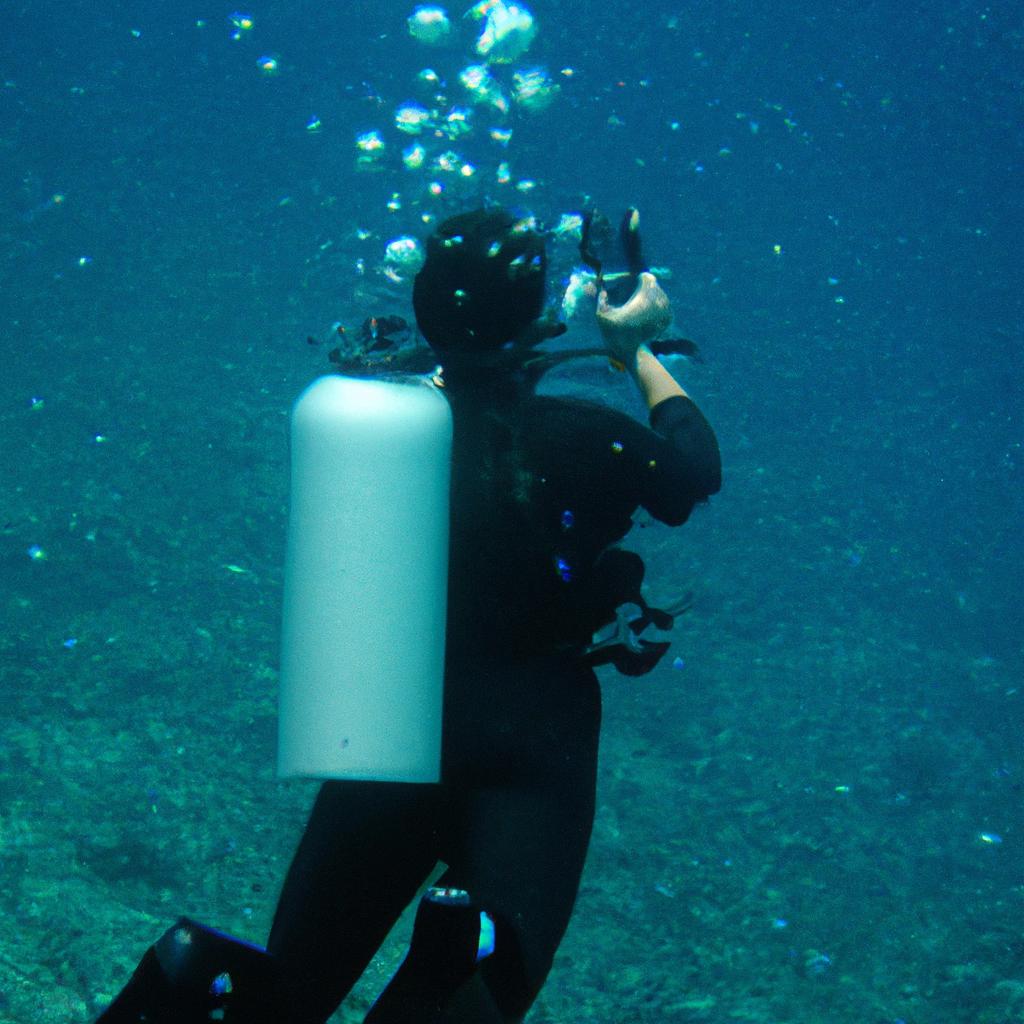Ocean currents play a vital role in Earth sciences, serving as a key component of the complex dynamics that shape our planet’s climate and ecosystems. These powerful flows of water have far-reaching effects on global weather patterns, marine life distribution, and even human activities such as shipping and fishing. For instance, consider the Gulf Stream, a well-known ocean current that originates in the Gulf of Mexico and influences both North American and European climates. Its warm waters not only impact the temperature along coastal regions but also contribute to the formation of hurricanes in the Atlantic Ocean. This example highlights just one of many intricate connections between ocean currents and various aspects of Earth’s systems.
Understanding these oceanic movements requires interdisciplinary research efforts from scientists across fields such as physics, biology, geology, and climatology. The study of ocean currents encompasses an array of topics including fluid mechanics, thermodynamics, biogeochemical processes, and satellite remote sensing techniques. By investigating factors influencing their origins, intensities, speeds, directions, and interactions with other forces like wind patterns or seafloor topography, researchers can unravel critical insights about how oceans function globally. Furthermore, this knowledge provides valuable information for predicting future changes in climate patterns or assessing potential impacts on marine ecosystems due to human-induced climate change.
One example of how ocean currents are affected by climate change is the weakening of the Atlantic Meridional Overturning Circulation (AMOC). The AMOC is a crucial component of global ocean circulation and plays a significant role in regulating Earth’s climate. As greenhouse gas emissions warm the planet, melting ice from Greenland adds freshwater to the North Atlantic Ocean, disrupting the density-driven sinking of water that drives the AMOC. This disruption can lead to changes in regional climates, such as cooling in northern Europe and altered precipitation patterns.
Additionally, rising sea surface temperatures due to climate change can influence the distribution and behavior of marine species. Some organisms rely on specific temperature ranges for optimal survival and reproduction. Changes in ocean currents can lead to shifts in nutrient availability, affecting ecosystems and potentially leading to changes in fish populations or harmful algal blooms.
Overall, understanding ocean currents and their interactions with other Earth systems is critical for predicting future climate trends, assessing impacts on marine ecosystems, and developing strategies for adapting to or mitigating the effects of climate change. Ongoing research efforts continue to enhance our knowledge of these complex phenomena and their implications for our planet.
The Role of Ocean Currents in Climate
Ocean currents play a crucial role in shaping Earth’s climate. One example that highlights their significance is the Gulf Stream, a powerful warm current originating from the Gulf of Mexico and flowing along the eastern coast of North America before crossing the Atlantic Ocean towards Western Europe. This case study demonstrates how ocean currents can transport heat over vast distances, thereby influencing regional climates.
The impact of ocean currents on climate can be observed through several key mechanisms:
-
Heat Transfer: Ocean currents act as conduits for transferring heat across different regions of the planet. Warm currents carry tropical waters to higher latitudes, resulting in milder climates in areas they pass through. Conversely, cold currents bring cooler water masses from polar regions towards equatorial zones, tempering temperatures in those regions.
-
Moisture Distribution: Along with heat transfer, ocean currents also contribute to the distribution of moisture throughout the globe. As warm air passes over warmer surface waters, it absorbs more moisture, leading to increased humidity levels and potentially affecting precipitation patterns when this air reaches land.
-
Carbon Storage: Deep ocean currents have a significant role in regulating carbon dioxide concentrations by transporting dissolved gases between surface and deep waters. This process helps sequester atmospheric CO2 by storing it within the depths of the oceans.
-
Ecosystem Support: The movement of ocean currents influences nutrient availability within marine ecosystems. Upwelling caused by offshore winds or diverging surface flows brings nutrients from deeper waters to the surface, promoting phytoplankton growth and supporting diverse marine food webs.
To illustrate these effects visually:
| Impact | Mechanism | Example |
|---|---|---|
| Climate Regulation | Heat Transfer | Gulf Stream |
| Precipitation Patterns | Moisture Distribution | El Niño/La Niña |
| Carbon Sequestration | Dissolved Gas Transport | Global Conveyor Belt |
| Ecological Productivity | Nutrient Upwelling | Humboldt Current |
Understanding the role of ocean currents in climate is crucial for comprehending Earth’s complex systems and predicting future changes. In the subsequent section, we will explore different types of ocean currents to delve deeper into their diverse characteristics and impacts on our planet’s climate dynamics.
Types of Ocean Currents
Ocean Currents: A Key Component of Earth Sciences
The Role of Ocean Currents in Climate has shed light on the significant impact that these dynamic flows of water have on weather patterns and global temperature regulation. Now, let us delve deeper into understanding the different types of ocean currents and their characteristics.
To illustrate the diversity of ocean currents, consider the example of the Gulf Stream. This powerful warm current originates in the Gulf of Mexico and travels along the eastern coast of North America before crossing the Atlantic Ocean towards Europe. The Gulf Stream plays a crucial role in shaping regional climates by transporting heat from tropical regions to higher latitudes, resulting in milder winters along its path.
Understanding ocean currents requires recognizing their various attributes and behaviors. Here are some key aspects:
- Directionality: Ocean currents can flow in both horizontal and vertical directions, influenced by factors such as wind patterns, temperature gradients, and Earth’s rotation.
- Speed: Current velocities vary greatly depending on location and depth. While surface currents tend to be faster due to strong winds, deep-sea currents move at slower speeds.
- Temperature: Warm and cold-water masses contribute to distinct current systems with varying thermal properties. These temperature contrasts influence climate patterns globally.
- Transported Materials: Ocean currents serve as conduits for transferring heat, nutrients, gases, pollutants, marine organisms, sediments, and even microplastics across vast distances.
Emphasizing the significance of these features is essential to grasp how ocean currents shape our planet’s interconnected ecosystems. To further comprehend this complexity visually, refer to the table below showcasing four major oceanic gyres:
| Gyre | Location | Characteristics |
|---|---|---|
| North Atlantic | Between N.America & Africa | Transports warm water northward; influences European climate |
| South Atlantic | Between S.America & Africa | Anticyclonic circulation; carries cold water towards the equator |
| Indian Ocean | In the Indian Ocean basin | Drives monsoon patterns; transports warm water to Southeast Asia |
| North Pacific | Between N.America & Asia | Largest gyre; affects climate in western U.S. and East Asia |
As we delve into the causes of ocean currents, it becomes evident that their intricate interplay with multiple factors shapes our planet’s climate system. By understanding these mechanisms, scientists can further unravel the complexities of Earth’s interconnected processes.
Next section: Causes of Ocean Currents
Causes of Ocean Currents
Ocean currents play a crucial role in the Earth’s climate system, shaping weather patterns and distributing heat around the globe. Understanding the causes of these currents is essential for comprehending our planet’s complex dynamics. In this section, we will explore the various factors that contribute to the formation and movement of ocean currents.
One example highlighting the significance of ocean currents is the Gulf Stream, a powerful warm current that originates in the Gulf of Mexico and flows northward along the eastern coast of North America. This current has a profound impact on both marine life and regional weather patterns. For instance, it helps moderate temperatures along coastal areas, making them more habitable for certain species. Additionally, its warm waters influence atmospheric conditions, contributing to milder winters in parts of Europe such as Great Britain.
The causes behind ocean currents can be attributed to several key factors:
- Wind: The primary driving force behind surface currents is wind. As winds blow across the water’s surface, they create friction which pushes water molecules, setting them into motion.
- Temperature and density differences: Variations in water temperature and salinity lead to changes in seawater density. These variations cause vertical movements known as upwelling or downwelling that ultimately affect horizontal circulation patterns.
- Coriolis effect: Due to Earth’s rotation, moving air masses are deflected to the right in the Northern Hemisphere and to the left in the Southern Hemisphere—a phenomenon known as the Coriolis effect. This deflection also applies to ocean currents resulting from wind-driven forces.
- Continental barriers: Landmasses act as physical barriers that redirect oceanic flow by deflecting currents or creating gyres (large circular systems). Such interactions between landmasses and oceans significantly influence global circulation patterns.
To further illustrate these concepts visually, consider Table 1 below depicting contrasting characteristics associated with different types of ocean currents:
Table 1: Characteristics of Ocean Currents
| Type | Movement | Temperature | Example |
|---|---|---|---|
| Surface currents | Horizontal | Varies | Gulf Stream |
| Deep ocean currents | Vertical & | Cold | Antarctic Bottom Water |
| horizontal | |||
| Western boundary | Fast-moving, | Warm | Kuroshio Current (Japan) |
| currents | narrow |
Understanding the causes of ocean currents is vital for scientists and policymakers alike. By comprehending these mechanisms, we can better predict climate patterns, assess changes in marine ecosystems, and develop strategies to mitigate the impacts of human activities on our oceans.
The Global Conveyor Belt: A Major Ocean Current System
Ocean Currents: A Key Component of Earth Sciences
Having explored the causes of ocean currents in the previous section, it is now important to delve into one particular major ocean current system known as the Global Conveyor Belt. This intricate network of currents plays a crucial role in shaping our planet’s climate and maintaining global heat distribution.
To better understand the significance of the Global Conveyor Belt, consider the hypothetical scenario where this current system abruptly halted. As an example, let us imagine a sudden disruption in the North Atlantic Deep Water formation due to a significant decrease in salinity levels caused by excessive melting icebergs. Without this cold, dense water sinking to the depths and flowing southward along the seafloor, there would be far-reaching consequences on both regional and global scales.
The impacts resulting from such a disturbance within the Global Conveyor Belt are manifold:
- Disrupted heat transport: The flow of warm surface waters moving towards high latitudes would diminish considerably, leading to colder temperatures in these regions.
- Altered weather patterns: With changes in temperature distribution, atmospheric circulation patterns could be disrupted, influencing precipitation patterns around the world.
- Shifted marine ecosystems: Nutrient-rich deep-sea waters that support countless organisms may fail to reach their usual destinations. Consequently, marine life reliant on these nutrients for survival could face severe challenges.
- Impacted fishing industries: Regions heavily dependent on fisheries might experience declines in fish populations due to altered nutrient availability and shifting habitats.
Table: Potential Consequences of Disrupting the Global Conveyor Belt
| Impact | Description |
|---|---|
| Decreased surface temperatures | Colder climates at higher latitudes due to diminished flow of warm surface waters |
| Altered precipitation patterns | Changes in atmospheric circulation affecting rainfall distribution globally |
| Ecological disruptions | Impacts on marine ecosystems as nutrient-rich deep-sea waters fail to reach their usual destinations |
| Declines in fish populations | Fishing industries facing challenges due to altered nutrient availability and shifting habitats |
Understanding the intricate interplay between ocean currents, climate systems, and marine ecosystems is vital for comprehending Earth’s dynamic processes. In the subsequent section on “Impacts of Ocean Currents on Marine Life,” we will explore how these powerful currents shape various aspects of marine biodiversity and drive ecological dynamics without explicitly stating a transition.
Impacts of Ocean Currents on Marine Life
Ocean currents play a fundamental role in shaping the Earth’s climate system and have significant impacts on various aspects of marine life. Understanding these complex systems is crucial for comprehending the intricate dynamics of our planet’s oceans. In this section, we will explore the diverse effects of ocean currents on marine ecosystems.
To illustrate the profound influence of ocean currents, let us consider the case study of the Gulf Stream. This powerful warm current flows along the eastern coast of North America before crossing the Atlantic Ocean towards Europe. Its thermal energy significantly affects both regional climates and global weather patterns. For instance, it warms up coastal areas such as western Europe, making them milder than other regions at similar latitudes. The Gulf Stream also plays a key role in transporting heat from tropical to polar regions, regulating temperature gradients globally.
The impact of ocean currents on marine life is multifaceted and far-reaching. Considerable variations in water temperature and nutrient content occur due to these currents’ movement patterns, giving rise to unique habitats that support diverse ecosystems. Some specific effects include:
- Enhanced biodiversity: Ocean currents create favorable conditions for different species by bringing together nutrients and food sources.
- Migration facilitation: Certain species rely on ocean currents for their seasonal migrations or reproductive cycles.
- Ecological connectivity: Currents act as highways, connecting geographically distant ecosystems and allowing for exchange between populations.
These examples demonstrate how ocean currents shape not only individual organisms but entire ecological communities. To further understand their significance, let us examine some notable impacts through a table:
| Impact | Description | Example |
|---|---|---|
| Nutrient distribution | Ocean currents transport nutrients across vast distances, enriching waters where they are scarce | Upwelling zones off the coasts of Peru and Namibia |
| Coral bleaching prevention | Cool-water currents can mitigate coral bleaching events by providing relief from temperature stress | The California Current |
| Larval dispersal | Ocean currents aid in the dispersion of larval organisms, allowing for colonization and genetic diversity | East Australian Current |
| Carbon sequestration | Certain ocean currents contribute to carbon storage through upwelling processes and the biological pump | Benguela Current |
This table showcases how ocean currents not only impact marine life directly but also play essential roles in global biogeochemical cycles.
As we delve deeper into understanding the intricate relationship between ocean currents and their ecological implications, we will next explore human interactions with these dynamic systems. By recognizing our influence on these delicate ecosystems, we can strive for sustainable practices that ensure the preservation of both marine life and the planet’s overall well-being.
Human Interaction with Ocean Currents
Ocean Currents: A Key Component of Earth Sciences
Impacts of Ocean Currents on Marine Life have been extensively studied and documented, shedding light on the crucial role these currents play in shaping marine ecosystems. Building upon this understanding, it is imperative to explore Human Interaction with Ocean Currents, as our actions can profoundly impact both the oceanic environment and human societies.
One compelling example that illustrates the significance of human interaction with ocean currents is the Great Pacific Garbage Patch. This massive accumulation of floating debris primarily consists of plastics carried by ocean currents. As a case study, it highlights how human waste management practices and improper disposal contribute to the pollution of our oceans. The existence of such large-scale garbage patches serves as a stark reminder of the urgent need for sustainable waste management strategies worldwide.
To further comprehend the complex relationship between humans and ocean currents, we will examine several key aspects:
- Shipping Routes: Ocean currents play a vital role in determining shipping routes across the globe. Understanding current patterns helps optimize navigation efficiency and reduce fuel consumption, minimizing environmental impacts while ensuring timely delivery of goods.
- Climate Change: Increasing temperatures due to climate change influence ocean currents, leading to altered circulation patterns and potentially affecting weather systems globally. These changes can have far-reaching consequences for coastal communities, including extreme weather events like hurricanes or excessive rainfall.
- Fishing Industry: Many commercially important fish species rely on specific ocean current systems for breeding grounds or migration pathways. Changes in these currents directly impact fish populations and subsequently affect livelihoods dependent on fishing industries.
- Renewable Energy Sources: Harnessing energy from ocean currents through technologies like tidal turbines holds substantial promise for clean power generation. However, careful consideration must be given to potential ecological implications during installation and operation.
Table 1 presents an overview of some positive and negative interactions between humans and ocean currents:
| Positive Interactions | Negative Interactions |
|---|---|
| Utilization of ocean currents for shipping efficiency | Pollution of the oceans through improper waste disposal |
| Harnessing renewable energy from tidal turbines | Overfishing due to disruption in fish migration patterns |
In conclusion, comprehending the impact of human interactions with ocean currents is vital for sustainable development and preservation of marine ecosystems. By recognizing our influence on these intricate systems, we can strive towards responsible practices that promote environmental stewardship and ensure a harmonious coexistence between humans and the world’s oceans.










